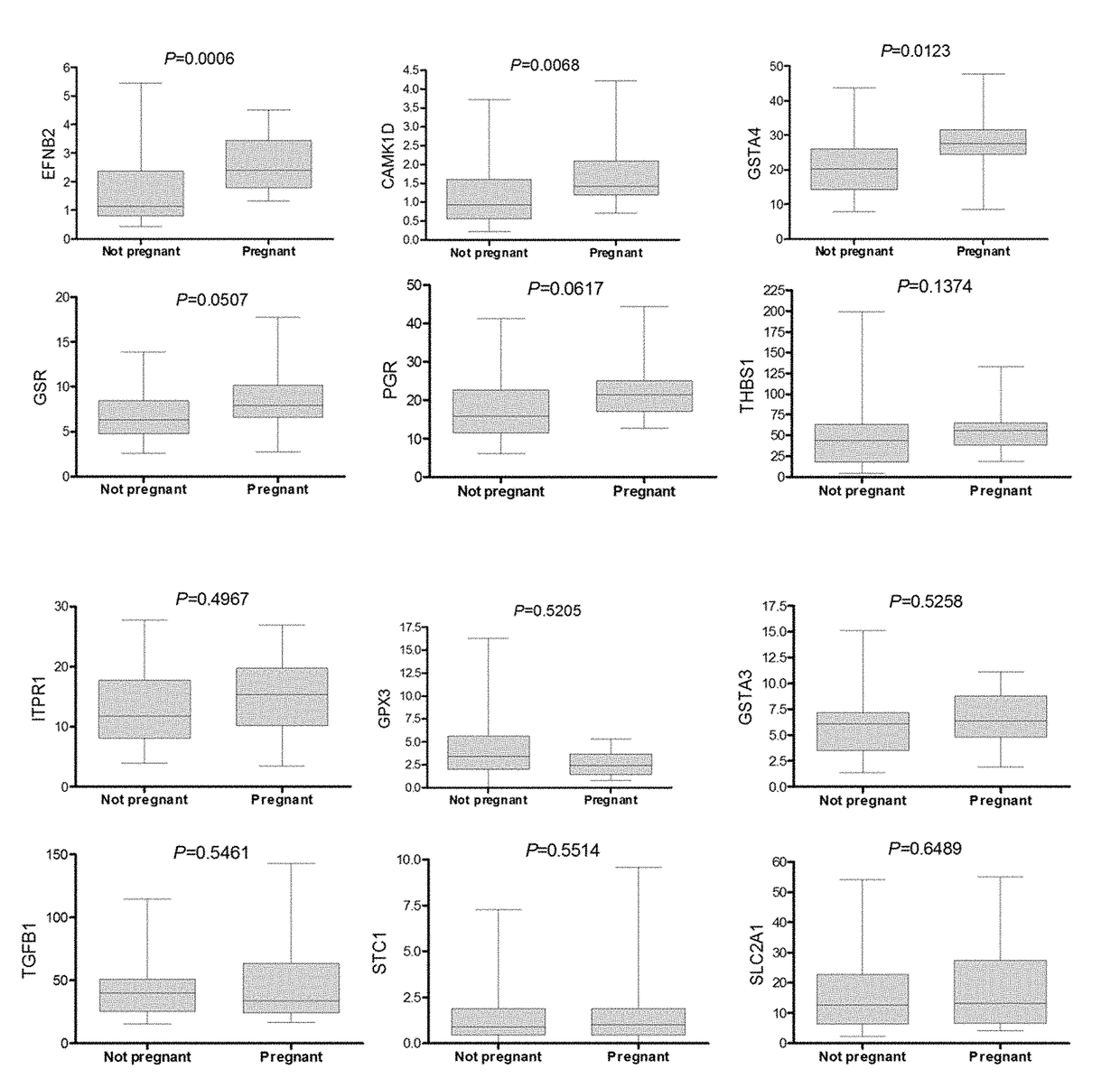Marker genes for oocyte competence
a technology of oocyte competence and marker genes, applied in the field of oocyte marker genes for oocyte competence, can solve the problem of limited relevance of the intermediate endpoints of full oocyte marker competen
- Summary
- Abstract
- Description
- Claims
- Application Information
AI Technical Summary
Benefits of technology
Problems solved by technology
Method used
Image
Examples
example 1
QPCR Analysis
[0173]Material and Methods
[0174]Patient Population
[0175]This study was approved by the Ethical Committee of the UZBrussel and the patients written consent was obtained. Forty seven ICSI patients were selected based on the embryo transfer policy (single embryo transfer) and ovarian stimulation protocol prescribed: GnRH antagonist in combination with recombinant follicle stimulating hormone (FSH) (Gonal-f. Merck-Serono, Geneva. Switzerland; n=4 or Puregon, MSD, Oss, The Netherlands; n=43). Causes of infertility were: male factor only (n=19), female factor only (ovulation disorder n=3 and tubal infertility n=2), combination male and female factor (OAT and endometriosis n=3) and idiopathic (n=20). Twenty patients had single embryo transfer on day 3 of culture, from these 10 became pregnant. Twenty seven patients had transfer on day 5, from these 9 became pregnant.
[0176]Collection of Human Cumulus Cells and Embryo Culture
[0177]Vaginal ultrasound was used to monitor follicula...
example 2
Exon Level Analysis
[0213]Three micro array experiments were performed and their resulting data led to 4 micro array analyses. Below respectively named micro array analysis 1, 2, 3 or 4 (see table 14 below). Array experiment 1 and 2 were used for data-mining, (for finding genes or exons of genes that are predictive for oocyte competence) and array experiment 3 was used for filtering the recurrent predictive genes (finding genes or exons that are more general applicable as they are predictive in different fertility centers and after slightly different treatments). The most novel analysis is based on micro array experiment 2 which comprises an intra patient and intra-cycle (oocytes from the same stimulation cohort) analysis for live birth.
[0214]Material:
[0215]For the three micro array experiments cumulus cells were collected as described before (Wathlet et al. 2011). The RNA was extracted using the Qiagen Rneasy micro kit as described in Wathlet et al. 2011. The quality and quantity of...
example 3
Retrospective Study
[0242]The retrospective study was performed with samples collected from 107 patients in two clinical sites. The QPCR was performed exon specific for 7 oocyte quality markers, from the 11 gene list (HSPH1 exon 2, HSPH1 exon 6, CAMK1D exon 1, CAMK1D exon 9, EFNB2, NCOA7, SASH1) and 2 endogenous controls (UBC and B2M) in three different batches (Table 9).
TABLE 9The samples available for the proof of concept studies.. B1 / 2 / 3 =batch 1 / 2 / 3, site 1 + 2 = European and Americanfertility center, patient pretreatment = GnRH antagonistcombined with rFSH or HP-hMG and the outcome pregnant =at least 2 weeks after transfer pregnant, not-Preg. =not pregnant after transfer, delayed = embryo developingslow and not considered for transferinter patient analysisintra-patientSample setB1B2B3AB3BB1 + 2 + 3Site 1 1121 + 2# Patients602614711 Anta + rFSHxxxxxAnta + HP-hMGxxxPregn371515148Not-Preg.2717897Delayed34124148Total9844273723
[0243]Cumulus Cell Collection:
[0244]The cumulus cell sam...
PUM
| Property | Measurement | Unit |
|---|---|---|
| diameter | aaaaa | aaaaa |
| Molecular weight | aaaaa | aaaaa |
| morphology | aaaaa | aaaaa |
Abstract
Description
Claims
Application Information
 Login to View More
Login to View More - R&D
- Intellectual Property
- Life Sciences
- Materials
- Tech Scout
- Unparalleled Data Quality
- Higher Quality Content
- 60% Fewer Hallucinations
Browse by: Latest US Patents, China's latest patents, Technical Efficacy Thesaurus, Application Domain, Technology Topic, Popular Technical Reports.
© 2025 PatSnap. All rights reserved.Legal|Privacy policy|Modern Slavery Act Transparency Statement|Sitemap|About US| Contact US: help@patsnap.com



